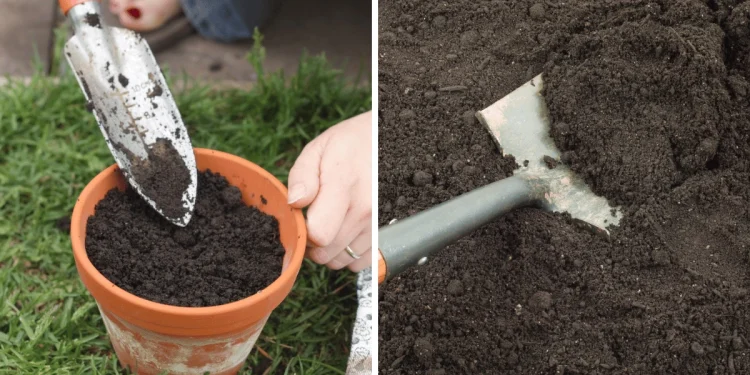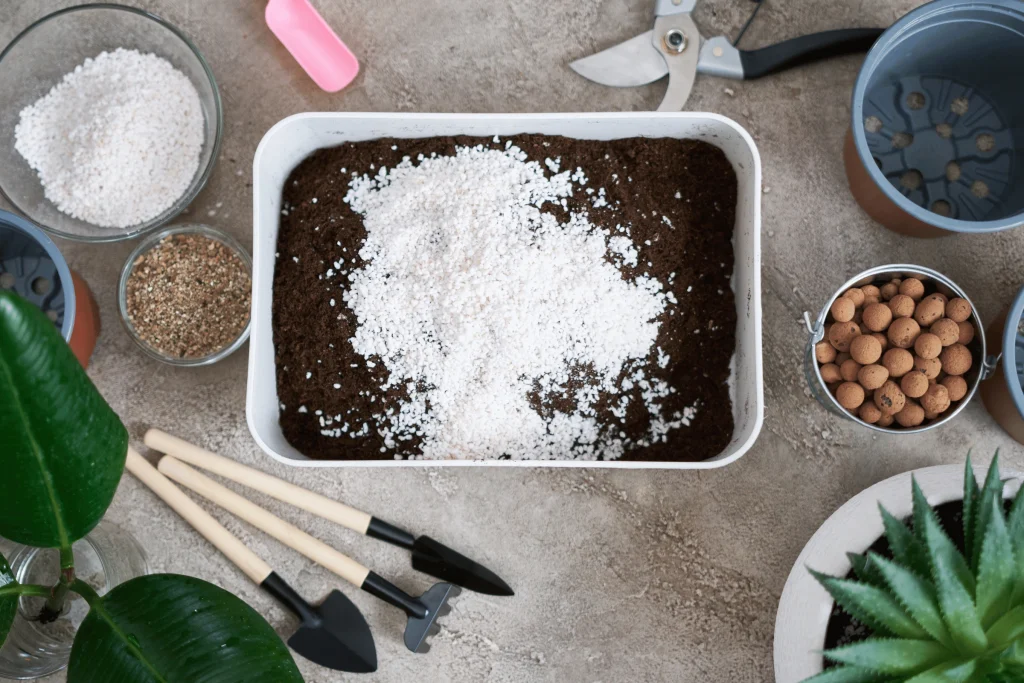The other day I went on a bit of a plant shopping spree. I mean, who can blame me? Those little guys just call out to me and say, ” Take me home! Give me a nice place to live!” And who am I to argue with that?
I came home with tons of new flowers, all ready to be potted. The only issue? I forgot to buy potting soil. I had all these beautiful plants but no soil to put them in.
But I was not about to let those plants die on my watch! I put my thinking cap on and started coming up with a plan. When it hit me. I got this big backyard, which is surprisingly composed of soil, so why don’t I use garden soil in a pot?
I scoured the yard for some garden soil, scooped it up, and used it to pot my new plant babies. And you know what? They’re thriving! Well, at least some of them. Which got me thinking, can you really use garden soil in pots? Or was I just lucky?
I did some digging (literally) and found out that I was just really lucky. Garden soil is heavy and can easily become compacted when used in containers, which can cause the roots of your plant to choke or drown.
The Difference Between Potting Soil and Garden Soil
When it comes to soil, it’s not a one size fits all situation. To be honest, many potting mixes are simply rebranded bags, but when it comes to potting soil and garden soil, you shouldn’t confuse them.
For starters, potting soil is specifically formulated for use in tight containers and is designed to be lightweight and well-draining. Garden soil, on the other hand, is heavier and is intended for use in the ground, where it can be naturally aerated and drained.
But now, let’s examine the rocky difference between potting soil and garden soil a little deeper.
Composition and Characteristics of Potting Soil

Potting soil is made up of a variety of organic and inorganic materials that work together to create an optimal growing environment for potted plants. Generally, the base of potting soil is made out of garden soil, but only in a small percentage.
Typically, potting soil is composed of peat moss, perlite, vermiculite, and sometimes sand or coconut coir.
Peat moss is harvested from peat bogs, and it’s a common ingredient because it holds onto moisture and ingredients. ensuring that they are available to the plant roots over time. Alternatively to peat moss, coconut coir can be added. This fibrous material comes as a byproduct of coconut harvesting and helps retain moisture in the soil.
Perlite and vermiculite are both lightweight materials that promote aeration and drainage, preventing soil compaction and waterlogging.
Some potting soils may also contain added nutrients or beneficial bacteria and fungi to promote plant growth.
Composition and Characteristics of Garden Soil
Garden soil, sometimes referred to as in-ground soil, is usually a lot cleaner when it comes to composition. That’s also why you can buy a lot more of it, in comparison to potting soil.
Garden soil is mainly composed of topsoil, which is the upper layer of soil that is high in organic matter and nutrients. If you dig around 4 inches down, you’ll encounter a dark-colored layer, and that’s the topsoil
It may contain a mix of sand, clay, and silt, as well as organic matter like compost, manure, and plant debris. Although these materials can be added by the manufacturer, the final composition and characteristics of garden soil can vary depending on factors like location, climate, and soil type.
Garden Soil vs Potting Soil
While garden soil and potting soil may appear similar at first glance, there are several key differences between them.
Garden soil is intended for use in the ground and is typically heavier and more compact than potting soil, while potting soil is formulated for use in containers and is designed to be lighter and more porous.
Potting soil also typically contains a greater proportion of organic matter and is more likely to be sterilized to prevent the growth of harmful microorganisms.
While garden soil may be rich in nutrients and organic matter, it can become compacted in containers and may lack the necessary drainage and aeration that potted plants require.
What Makes Soil Suitable for Growing Plants in Pots?
Let’s approach this from a different angle. As there are thousands of different soil brands, not every garden soil is composed the same. And some plants may do well even when living in garden soil if certain soil quantities are present.
Good Drainage
Proper drainage is crucial for potted plants to thrive.
The roots of plants need oxygen, and excessive water in the soil can suffocate them. A well-draining potting mix will help prevent roots from rotting and other water-related issues. However, it’s not all-solving, and you shouldn’t overwater your plants.
Materials such as perlite, vermiculite, or sand are good for increasing the water flow.
Good Moisture Control
Although it’s not a good thing to have your soil soaking wet all the time, it also shouldn’t be too dry.
The mix should have moisture-retaining properties that help to keep the soil consistently moist but not waterlogged. This can be achieved through the use of materials like peat moss, coconut coir, or composted pine bark. These materials can absorb water and release it slowly, providing a steady supply of moisture to the roots.
Oxygen!
The roots of plants take in oxygen and release carbon dioxide, just like the leaves. When the soil becomes too compacted, the roots won’t be able to breathe properly. This can lead to poor growth or even the death of your plant.
A good potting mix should contain materials that create air pockets in the soil, allowing oxygen to circulate around the roots.
Proper Nutrients
Finally, a good potting mix should contain the proper nutrients that plants need to grow and thrive.
In the wild, plants have access to a range of nutrients through the surrounding soil and the decomposition of organic matter. In a pot, however, the nutrients in the soil can become depleted over time.
A high-quality potting mix should contain a balanced blend of macronutrients like nitrogen, phosphorus, and potassium, as well as micronutrients like iron and calcium. Some potting mixes may also contain additional additives like mycorrhizae, which can help plants absorb nutrients more effectively.
Although a lack of nutrients can be dealt with by fertilizers, you should not fertilize newly repotted plants for at least three months. This is because the plant needs time to adjust to its new environment, and the lack of nutrients can manifest in the plant’s health during this time.
So what’s wrong with Garden Soil?
So why shouldn’t you use garden soil in a pot? Well, all the qualities a good potting soil should have are missing.
You can actually test that for yourself. If you go outside to dig up some soil, you will quickly notice that it’s either very muddy or dry as a desert. Garden soil tends to be much more compacted, causing water to pool around or, on the other hand, not letting any water in. And because it’s so dense, it also doesn’t allow enough oxygen to flow through.
Another issue is that garden soil can lack the proper nutrients that potted plants require.
It may also contain a good amount of weed seeds or pests. As it’s often taken directly from the ground and not sterilized before use. However, this one issue can be fixed. You can check my in-depth guide with 6+ techniques on how to sterilize soil.
I Accidentally used Garden Soil in Pots. Will it Kill my Potted Plants?
If you accidentally used garden soil in your pots, it won’t necessarily kill your plants. However, it easily can, depending on the type of soil. Especially if you took a big scoop of soil from your yard, it may contain a high amount of weed seeds or pests, in addition to the lack of good drainage and nutrients.
How do I fix that?
If you discovered my guide just a few hours or days after planting, everything could be reverted without any damage.
First, remove as much of the garden soil as possible from the pot. Then mix in some good potting soil or a soilless mix.
If your plants are already showing signs of stress, you may need to fertilize them to support their growth. However, using a fertilizer so early after planting could possibly burn the roots. So be really careful with that. It might not be needed, as most potting mixes contain fertilizer.
What can I Use in Pots Instead of Garden Soil?
Not every soil has to contain soil. I know it sounds wild, but that’s where soilless mixes come in.
Soilless potting mix might look exactly like soil, but it doesn’t even contain any soil. It’s a lightweight option that provides excellent drainage and moisture retention, made up of a mixture of peat moss, perlite, vermiculite, and other organic materials.
This allows it to be free of weed seeds, pests, and other unwanted contaminants that may be otherwise present. Plus, it is usually sterilized to prevent the spread of any diseases or pathogens.
In addition to soilless potting mix, you can also use compost, coir, and even sand or gravel.
Compost is a great choice because it is rich in nutrients and organic matter, but it can be heavy and may require the addition of perlite or vermiculite to improve drainage.
Coir, which is made from coconut husks, is another lightweight option that provides good drainage and moisture retention. Sand or gravel can also be used, but they are not as nutrient-rich as other options and may require more frequent fertilization.
Ultimately, the choice of what to use in your pots will depend on the needs of your specific plants and your personal preferences. But using standard potting still holds some benefits.
Can you Mix Potting Soil with Garden Soil?
It depends on the use case. If you are mixing potting soil with garden soil to use it outside, in the garden, it’s completely alright. However, it’s not recommended to use any quantity of garden soil in pots, as the two types of soil have different compositions and characteristics, and you don’t want to spread pests or grow unwanted weeds inside your houseplants.
Conclusion
While it might seem tempting to use garden soil in your containers, you should avoid it.
Garden soil on its own lacks the drainage, aeration, moisture control, and nutrients necessary to grow plants successfully in pots. When used by itself, it can become so compacted that water cannot drain and oxygen cannot flow.
Instead, opt for a high-quality potting mix that provides all the necessary qualities your plant needs to glow.
Remember, plants are like people, they need the right environment to flourish. So, let’s give them the best shot at success by using the proper soil in our pots. And as always, happy planting!













